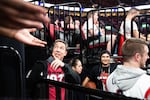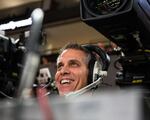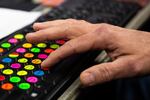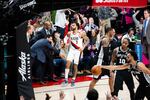It was late in the fourth quarter at the Moda Center. The Portland Trail Blazers had been chasing the visiting San Antonio Spurs all night long, but they’d just gone on a 9-to-4 run and taken the lead, a flurry capped off by a 3-pointer from star player Damian Lillard.
Suddenly, “Sandstorm,” a hyper-energetic song by Finnish DJ Darude, began thumping through the arena’s massive speaker system, and it raised all kinds of questions.
That night, I was there to find out how an NBA franchise uses audio to manipulate and enhance the gameday experience.
Perhaps most importantly, I wanted to learn why I was listening to a techno song at a basketball game.
The action actually started much earlier in the day, two hours before tipoff in a poorly lit auxiliary locker room. There, Todd Bosma led the game operations and events staff for the Portland Trail Blazers through a complex 46-page run of show for that evening’s game.
“I'm pretty much in charge of everything that you see and hear when you come to a Trail Blazers game that's not the guys playing basketball,” he explained.

Todd Bosma, director of game operations for the Portland Trail Blazers, during a National Basketball Association Game between the Trail Blazers and San Antonio Spurs at the Moda Center in Portland, Ore., Thursday, Feb. 6, 2020. Bosma oversees in-game audio, promotions and is the arena host during stoppages and timeouts.
Bradley W. Parks / OPB
Those duties include directing how music is used in the stadium, which, unlike some of his peers in the NBA, he tries to limit for effect.
“We don't play as much music as maybe some other venues do. We try to let the game breathe a little bit. People are here to watch basketball and they’re smart fans, so let them enjoy, hear the squeak of the sneakers, and get to that authentic experience a little bit.”
In fact, Bosma said, knowing when to be quiet is one of the hardest parts of the job.
“I think it is a fine line of being able to boost it when you need to, to sort of get the reaction and to get the crowd engaged, and being overproduced,” Bosma said. “And we try not to be overproduced because then you’ll lose credibility. But it's a dance. You have to sort of know when to lead and when to follow.”
I left the locker room and walked through the tunnel to the arena where I met David Jackson, better known as DJ O.G. ONE. Every game, he spins records at half court during the pregame shootaround.

DJ O.G.ONE. spins records at half-court before tipoff of the Portland Trail Blazers and San Antonio Spurs on Feb. 6, 2020. Players will request songs during pregame workouts. Carmelo Anthony (right) requested Jadakiss that night.
Bradley W. Parks / OPB
“I am the ambience,” Jackson said. “Pregame, I’m creating ambience for both the players and, you know, when doors open just kind of creating the energy of the arena. And then once the game starts, [I’m] just kind of waiting for my cue to hype the crowd up and maintain the energy.”
I asked the veteran DJ how he knows when he’s doing his job well. “When I see bodies moving,” he responded with a loud burst of infectious laughter.
As the shootaround ended, a flurry of activity followed. There were commercials, hype videos, player introductions and a performance by 35 children playing marimbas. And of course, there was the national anthem, which was courtesy of a string quartet from the Oregon Symphony. It was a sonic whirlwind leading right up to tipoff.

Left: A string quartet from the Oregon Symphony play the national anthem. Right: Damian Lillard bows his head and listens to the anthem.
Bradley W. Parks / OPB
With the game in full swing, I boarded an elevator to the top floor of the arena to find the nerve center of the whole operation. I walked down a long hallway, past a dozen or so luxury boxes, until I found the man with quite possibly the best view in the building — audio engineer Mick Boyt.
“I adjust the levels and set the tones for everything that we hear so that the fans can live in the experience,” Boyt yelled over the deafening roar of the crowd in the room.
That night, that experience was made up of 24 different audio sources. Boyt mixes and monitors everything from stadium announcer Mark Mason to the microphone that picks up the swoosh sound from the nets.
“It also picks up some of the player conversation that's happening around the hoop, which we have to try to limit at some portions,” Boyt said. “Uh, there's some language every once in a while that might get a little bit risky,” he sheepishly added.

John "JJ" Jackson during a National Basketball Association Game between the Portland Trail Blazers and San Antonio Spurs at the Moda Center in Portland, Ore., Thursday, Feb. 6, 2020. Jackson runs audio during Trail Blazers games, so most of the sound effects and music come from a laptop stuffed with thousands of sounds.
Bradley W. Parks / OPB
As I left the sound booth in the rafters and hiked back down to the court, the visiting team still held a narrow lead. At half court, I joined John “JJ” Jackson, the person responsible for playing most of the in-game audio and music. The view from these seats was almost as good as Boyt’s box, but they came with their own quirks. A television camera was literally 6 inches above my head, sweeping back and forth to keep up with the game. I found myself needlessly crouching like someone jumping out of a helicopter, but after a few minutes of riding shotgun with JJ I started to forget about it.
As I settled in, Damian Lillard made a free throw and stadium announcer Mark Mason yelled “Dame D.O.L.L.A,” Lillard’s nickname and hip-hop alter ego. Jackson quickly pressed a hotkey on a computer keyboard in front of him that played a cash register sound effect.
“He said ‘Dame D.O.L.L.A,’ so I wanted to throw in a little money,” he explained with a wry smile.

Stickers mark sounds in heavy rotation on John "JJ" Jackson's keyboard during a National Basketball Association Game between the Portland Trail Blazers and San Antonio Spurs at the Moda Center in Portland, Ore., Thursday, Feb. 6, 2020. The stickers mark particular sound effects or collections of sounds.
Bradley W. Parks / OPB
As the game progressed, Jackson played a corresponding sound or music clip for virtually everything that happened on the court. There are thousands of curated pieces of audio to choose from in the software suite he operates. Although the job is complex and requires real skill, Jackson readily admits that a lot of the gig is just going with your gut.
But then he told me how art meets science. It’s called a “hot timeout.”
“A hot timeout is when … basically the crowd’s up and we go on maybe a 10-0 run, [and] the other team calls a quick timeout. So, then we go right into something hot as far as the music [is concerned],” Jackson said.
To be clear, by "hot," he means fast. The higher the beats per minute in a song, the more engaged the crowd remains during the break in the action. As if right on cue, the Blazers took the lead and Spurs coach Gregg Popovich called a strategic timeout to regroup his team and take the air out of the raucous crowd. Jackson immediately cued up Darude’s “Sandstorm.”
So, why “Sandstorm”? Well, with 136 beats per minute, it’s hot as hell.

Coaches and fans react after Gary Trent (2) hits a three-pointer during a game between the Portland Trail Blazers and San Antonio Spurs on Thursday, Feb. 6, 2020. The game operations team will try to play music that carries energy from big plays or runs through timeouts.
Bradley W. Parks / OPB
When the teams took the court after the short break, the energy from the crowd was still palpable. The Blazers rode the momentum and ended up winning comfortably.
“Anytime we win it’s good. It makes everyone happy," Jackson said, beaming with the knowledge that he played a small part in the win.
But just like the referees, Todd Bosma said if his game operations team is doing their jobs well, you shouldn’t notice them.
“We’re not supposed to be seen,” Bosma said. “You’re supposed to just walk into the arena and expect that this just happens and not think about all the work that goes into it. Hopefully the Blazers win and we’re playing our victorious song as the team is walking off the floor, and everybody’s high-fiving each other and you know, we’ll reset and do it again in 24 to 48 hours.”

